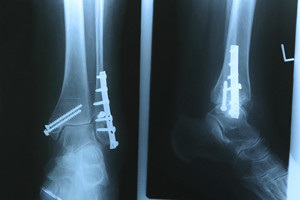Items filtered by date: July 2020
Pregnancy and Swollen Feet
 Swelling of the feet during pregnancy is incredibly common and usually not a cause for concern. While you may not have full control over your swelling, there are steps you can take that might reduce your discomfort. Avoiding standing for prolonged periods of time, resting your feet regularly, and not going outside in hot weather may help reduce swelling. Decreasing your daily intake of salt, and increasing your intake of potassium may also help. Consuming too much caffeine might increase swelling, so opt for beverages with low or no caffeine content, such as water. If you experience painful, swollen feet during pregnancy, a podiatrist may be able to help.
Swelling of the feet during pregnancy is incredibly common and usually not a cause for concern. While you may not have full control over your swelling, there are steps you can take that might reduce your discomfort. Avoiding standing for prolonged periods of time, resting your feet regularly, and not going outside in hot weather may help reduce swelling. Decreasing your daily intake of salt, and increasing your intake of potassium may also help. Consuming too much caffeine might increase swelling, so opt for beverages with low or no caffeine content, such as water. If you experience painful, swollen feet during pregnancy, a podiatrist may be able to help.
Pregnant women with swollen feet can be treated with a variety of different methods that are readily available. For more information about other cures for swollen feet during pregnancy, consult with Matthew McQuaid, DPM from Lake Mendocino Podiatry. Our doctor will attend to all of your foot and ankle needs.
What Foot Problems Can Arise During Pregnancy?
One problem that can occur is overpronation, which occurs when the arch of the foot flattens and tends to roll inward. This can cause pain and discomfort in your heels while you’re walking or even just standing up, trying to support your baby.
Another problem is edema, or swelling in the extremities. This often affects the feet during pregnancy but tends to occur in the later stages.
How Can I Keep My Feet Healthy During Pregnancy?
- Wearing orthotics can provide extra support for the feet and help distribute weight evenly
- Minimize the amount of time spent walking barefoot
- Wear shoes with good arch support
- Wear shoes that allow for good circulation to the feet
- Elevate feet if you experience swelling
- Massage your feet
- Get regular, light exercise, such as walking, to promote blood circulation to the feet
If you have any questions please feel free to contact our offices located in Lakeport and Ukiah, CA . We offer the newest diagnostic and treatment technologies for all your foot and ankle needs.
What Are Flat Feet?
Flat feet is a condition when the arch, the curved part of the sole of your foot, touches the floor when you stand. Flat feet typically occur due to the foot not developing properly during childhood. However, feet may also become flat over time, as daily wear and tear of the foot causes the arch to weaken and fall. In some cases, people with flat feet exhibit no symptoms at all. In other cases, flat feet can cause issues ranging from mild discomfort to severe pain. Left untreated, pain could worsen and cause complications to the knees, hips, and spine. If you have flat feet and are experiencing pain or discomfort, consult with a podiatrist.
Flatfoot is a condition many people suffer from. If you have flat feet, contact Matthew McQuaid, DPM from Lake Mendocino Podiatry. Our doctor will treat your foot and ankle needs.
What Are Flat Feet?
Flatfoot is a condition in which the arch of the foot is depressed and the sole of the foot is almost completely in contact with the ground. About 20-30% of the population generally has flat feet because their arches never formed during growth.
Conditions & Problems:
Having flat feet makes it difficult to run or walk because of the stress placed on the ankles.
Alignment – The general alignment of your legs can be disrupted, because the ankles move inward which can cause major discomfort.
Knees – If you have complications with your knees, flat feet can be a contributor to arthritis in that area.
Symptoms
- Pain around the heel or arch area
- Trouble standing on the tip toe
- Swelling around the inside of the ankle
- Flat look to one or both feet
- Having your shoes feel uneven when worn
Treatment
If you are experiencing pain and stress on the foot you may weaken the posterior tibial tendon, which runs around the inside of the ankle.
If you have any questions please feel free to contact our offices located in Lakeport and Ukiah, CA . We offer the newest diagnostic and treatment technologies for all your foot and ankle needs.
What Can Cause a Stress Fracture?
 A stress fracture is a common sports injury, often brought upon by overuse and repetitive activities. Stress fractures can occur when small cracks form in the bone. Quite often athletes may develop a stress fracture due to errors in their training technique. For example, it can be very damaging to suddenly increase the intensity of a work-out regime or to increase the amount of walking one does. Increasing the difficulty of training over the course of a few months can be much safer as opposed to a few weeks. Other factors such as improper equipment can also lead to the development of a stress fracture. Worn-out footwear, or shoes that are too stiff can also be damaging to how one performs their training. For further information on how to prevent getting a stress fracture, please consult with a podiatrist.
A stress fracture is a common sports injury, often brought upon by overuse and repetitive activities. Stress fractures can occur when small cracks form in the bone. Quite often athletes may develop a stress fracture due to errors in their training technique. For example, it can be very damaging to suddenly increase the intensity of a work-out regime or to increase the amount of walking one does. Increasing the difficulty of training over the course of a few months can be much safer as opposed to a few weeks. Other factors such as improper equipment can also lead to the development of a stress fracture. Worn-out footwear, or shoes that are too stiff can also be damaging to how one performs their training. For further information on how to prevent getting a stress fracture, please consult with a podiatrist.
Activities where too much pressure is put on the feet can cause stress fractures. To learn more, contact Matthew McQuaid, DPM from Lake Mendocino Podiatry. Our doctor can provide the care you need to keep your pain free and on your feet.
Dealing with Stress Fractures of the Foot and Ankle
Stress fractures occur in the foot and ankle when muscles in these areas weaken from too much or too little use. The feet and ankles then lose support when walking or running from the impact of the ground. Since there is no protection, the bones receive the full impact of each step. Stress on the feet can cause cracks to form in the bones, thus creating stress fractures.
What Are Stress Fractures?
Stress fractures occur frequently in individuals whose daily activities cause great impact on the feet and ankles. Stress factors are most common among:
- Runners
- People affected with Osteoporosis
- Tennis or basketball players
- Gymnasts
- High impact workouts
Symptoms
Pain from the fractures occur in the area of the fractures and can be constant or intermittent. It will often cause sharp or dull pain with swelling and tenderness. Engaging in any kind of activity which involves high impact will aggravate pain.
If you have any questions please feel free to contact our offices located in Lakeport and Ukiah, CA . We offer the newest diagnostic and treatment technologies for all your foot and ankle needs.
It's Time for Beautiful Feet
Location of Pain From Cuboid Syndrome
 Pain and discomfort that exists from cuboid syndrome is generally felt on the outer edge of the foot, which is the same side of your little toe. The cuboid bone is one of several small bones located in each foot, and may become dislocated from overuse, or from frequently participating in running and jumping activities. Since it is sometimes difficult to pinpoint exactly where pain is coming from, this condition is often misdiagnosed or confused with a stress fracture. When a proper evaluation is performed, the correct treatment can begin. If you are experiencing pain around the middle of the foot, or at the base of the fourth and fifth toes, it is strongly suggested that you consult with a podiatrist as quickly as possible who can guide you toward effectively treating this condition.
Pain and discomfort that exists from cuboid syndrome is generally felt on the outer edge of the foot, which is the same side of your little toe. The cuboid bone is one of several small bones located in each foot, and may become dislocated from overuse, or from frequently participating in running and jumping activities. Since it is sometimes difficult to pinpoint exactly where pain is coming from, this condition is often misdiagnosed or confused with a stress fracture. When a proper evaluation is performed, the correct treatment can begin. If you are experiencing pain around the middle of the foot, or at the base of the fourth and fifth toes, it is strongly suggested that you consult with a podiatrist as quickly as possible who can guide you toward effectively treating this condition.
Cuboid syndrome, also known as cuboid subluxation, occurs when the joints and ligaments near the cuboid bone in the foot become torn. If you have cuboid syndrome, consult with Matthew McQuaid, DPM from Lake Mendocino Podiatry. Our doctor will assess your condition and provide you with quality foot and ankle treatment.
Cuboid syndrome is a common cause of lateral foot pain, which is pain on the outside of the foot. The condition may happen suddenly due to an ankle sprain, or it may develop slowly overtime from repetitive tension through the bone and surrounding structures.
Causes
The most common causes of cuboid syndrome include:
- Injury – The most common cause of this ailment is an ankle sprain.
- Repetitive Strain – Tension placed through the peroneus longus muscle from repetitive activities such as jumping and running may cause excessive traction on the bone causing it to sublux.
- Altered Foot Biomechanics – Most people suffering from cuboid subluxation have flat feet.
Symptoms
A common symptom of cuboid syndrome is pain along the outside of the foot which can be felt in the ankle and toes. This pain may create walking difficulties and may cause those with the condition to walk with a limp.
Diagnosis
Diagnosis of cuboid syndrome is often difficult, and it is often misdiagnosed. X-rays, MRIs and CT scans often fail to properly show the cuboid subluxation. Although there isn’t a specific test used to diagnose cuboid syndrome, your podiatrist will usually check if pain is felt while pressing firmly on the cuboid bone of your foot.
Treatment
Just as the range of causes varies widely, so do treatments. Some more common treatments are ice therapy, rest, exercise, taping, and orthotics.
If you have any questions, please feel free to contact our offices located in Lakeport and Ukiah, CA . We offer the newest diagnostic and treatment technologies for all your foot care needs.


